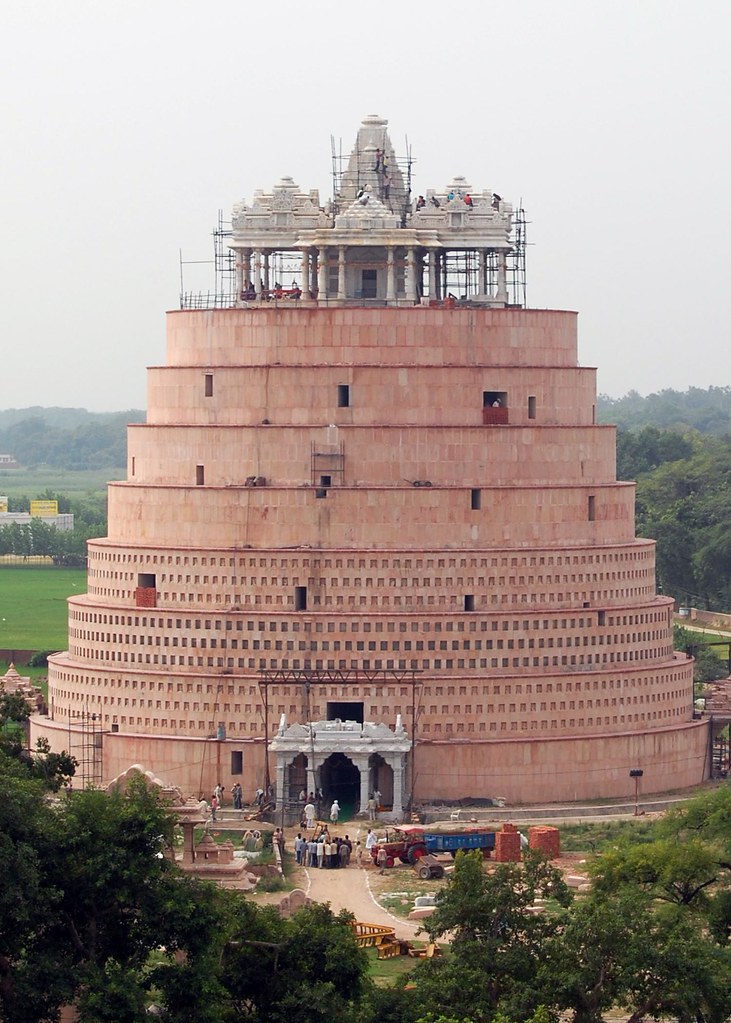
Digamber Jain Jambudweep Mandir at Hastinapur
In the year 1965, during the Shravanbelgola (Karnataka) Chaturmas, Supreme Jain Sadhvi Param Pujya 105 Ganini Pramukh Aryika Shiromani Shri Gyanmati Mataji saw the whole structure of Madhyalok (Middle universe) along with amazing Terahdweep (13 islands) in her meditation (Pindasth Dhyan) in the holy feet of Lord Bahubali at Vindhya mountain. By great fortune all her meditational achievement was testified by the ancient Jain scriptures of 2000 years back like Tiloypannatti, Triloksar etc. and so she developed the deep desire to for realize this structure somewhere on the earth. Ultimately Hastinapur was chosen as the desired site.
After the on foot journey (Vihar) of Karnataka, Maharashtra, Gujrat, Bihar, Bengal, Rajasthan, Madhya Pradesh, Delhi etc. Pujya Aryika Mataji, along with the sangh, reached Hastinapur Tirth in 1974. And from the same day new history was written on the pages of Hastinapur. It is a miraculous chance that crores of years back, in the end of the third Kal (era), the first Ahar (meals)-donor of the first Tirthankar Lord Rishabhdev i.e. Yuvrar Shreyans of Hastinapur saw Sumeru Mountain in his dream and today in fifty (pancham) kal, the whole Jambudweep with Sumeru Mountain is becoming visible on the same pious land of Hastinapur by the inspiration of Pujya Gyanmati Mataji.
Unique circular structures of Jain Geography 'Jambudweep' has been constructed with white & coloured marble stones in the diameter of 250 ft. Along with it, 101 ft. high Sumeru Mountain of light pink marble in the just middle of Jambudweep is capable of attracting the masses.
The structure of Jambudweep, depicting Jain geography, is the model of our grand universe. Centrally located sumeru mountain is considered as the central point it. Due to the location of Sumeru, Jambudweep structure has four distinct regions in East, West, North and South. The East region is known as East Videh Kshetra and the West region as west Videh Kshetra. In the South direction, with the prominence of Bharat Kshetra, Himuan etc mountains, Ganga-Sindhu etc. rivers, Haimurat etc. Kshetras, Bhogbhumis (lands of enjoyment) with Kalpa-Vrikshas (wish fulfilling trees), Chaityalayas (Temples), palaces of deities, ponds, gardens etc. have been shown while same structures have been built with different names in the North direction, having the prominence of Airavat Kshetra.
Just near the Sumeru Mountain, Jambu Vriksha (rose-apple tree) in the North and Shalmali Vriksha in the south have been shown. Both of these metal trees have one temple each. If one first reads the description of these structures in scriptures like Tiloypannatti, Triloksar, Tatvasrtha Sutra etc. and then observes all the details at Jambudweep, he can gain real knowledge about it.
According to our scriptures, the present world (all the six continents) is situated in the South of the Bharat Kshetra and the rest of the grand Universe is unavailable to us.
Kurt Titze in his book Jainism. A Pictorial Guide to the Religion of Non-Violence (New Delhi, Motilal Banarsidass Publishers, 1998, p. 138) writes on Hastinapur and Jambudweep Mandir:
"Hastinapur, the legendary capital of the Mahabharata epic outside of which the great battle between the Pandavas and the Kurus is thought to have been fought - now just a village about a hundred kilometres north-east of Delhi - is a major place of pilgrimage for both Shvetambaras and Digambaras. It was here, according to tradition, that Rishabha, the former king of Ayodhya, after he had relinquished his kingdom in favour of his two sons Bharata and Bahubali and accepted the life of a homeless ascetic, was offered acceptable food in an acceptable manner for the first time. The fortunate donor was a prince of Hastinapur who happened to know the proper way of giving food to a Jaina monk. The nourishment he offered was sugar-cane juice. Once a year, on the third day of the bright fortnight of the month Vaishaka (May/June), thousands of Jaina pilgrims from all over India gather at Hastinapur to commemorate this event.
Wars, floods and vandalism have left nothing standing of ancient Hastinapur. The Ganges, on whose western bank this famous city once stood, has in the course of many centuries found a new bed some distance to the east. During excavations, soon after Independence, a big statue of a standing Shantinatha was found which was dated at 1176. The present temples are of a much later date. Hastinapur is said to be the birth-place of the Tirthankaras Shantinatha, Kunthunatha and Aranatha; their footprints can be seen on a small hill nearby.
With the completion of the Jambu-dvipa shrine in 1985, Hastinapur has become a favourite centre for studying Jaina cosmology and cosmography, an extremely difficult subject to study, not'only for Westerners.
The inspiration for "constructing, on scale as far as possible, a model of Jambudvipa according to the details available in Jaina scriptures" came not from a mathematical minded male scholar but from the lady ascetic Aryika Jnanmati, a Digambara nun.
Jambu-dvipa has a diameter of 100,000 yojanas (one yojana = 8/9 miles or c. 13.5 km). It comprises seven islands of which only the inner two plus one half of the third one are fit for humans and five-sensed animals. In the middle stands Mount Sumeru or Meru (there are fourteen more names for it) with a jambu tree on top. jambu means rose-apple; thus jambudvipa may be translated into 'Continent of the Rose-apple tree'. Jambudvipa is but the innermost sector of the Jaina universe, and a relatively tiny part of it. For further details consult The Jain Cosmology by Colette Caillat and Ravi Kumar."
Impressions of Jambudweep Mandir at Hastinapur











Ashtapad Temple












